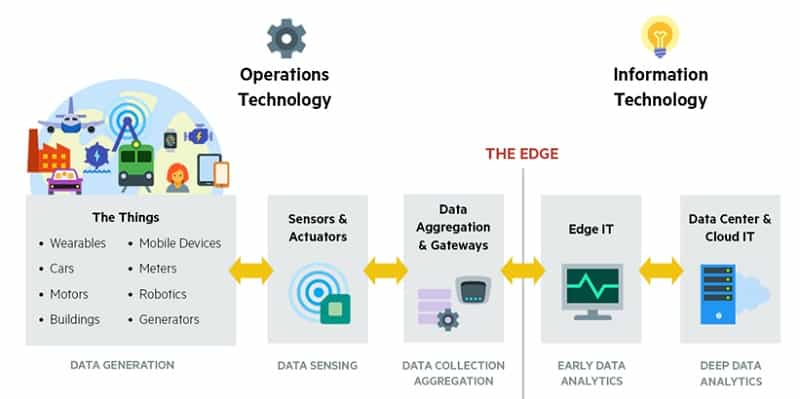Home »
IoT (Internet of Things) Tutorial
Edge Computing in IoT (Internet of Things)
In this tutorial, we will learn what is edge computing and key capabilities of edge computing, and types of edge computing.
By Shahnail Khan Last updated : August 16, 2023
Edge computing is an essential concept in the realm of IoT. It signifies a transformative approach to processing data generated by IoT devices. Edge computing allows IoT devices to be more independent by processing and analysing data locally, near the source, as opposed to only depending on centralised cloud servers. It marks a fundamental shift in how IoT devices manage data, with several benefits for IoT applications. In this response, we'll go into detail on what edge computing is, how it works, and why it's important for the Internet of Things.
What is Edge Computing?
Edge computing refers to the sort of computing that occurs at or close to the network's edge. As the processing occurs at or near the device layer, the data is sent to the central server. Near the source of data, most actions take place instantly. The main goal is to improve real-time decision-making skills while reducing latency.

Image source
Key Capabilities of Edge Computing
1. Local Data Processing
Edge computing enables IoT devices to process data locally, at the point where the data is generated. This means they don't have to transfer all the data to distant servers, which might take time. Instead, they quickly process it locally, making things happen faster. For things that require quick decisions, like self-driving cars or factories, this is crucial since they can't afford to wait.
2. Decentralization
Edge computing is all about spreading technology, comparable to cloud computing but without the hype. Edge computing is all about spreading technology, comparable to cloud computing, but without the hype. Decisions are made close to where the data is, which speeds up operations. Additionally, it reduces the transferring of data all over the place, which is great for conserving time and resources.
3. Cost-Effective
Edge computing expands the capabilities of cloud computing, making it cost-effective in real-time IoT applications. It lessens the requirement for extensive data transfers to central servers, reducing bandwidth and operational expenses.
4. Scalability
Edge technology is all about preparing for a future filled with numerous IoT devices. Edge technology is built to handle a lot of sensors, perhaps even up to 100,000 in the next ten years! As more gadgets join the IoT, edge computing can keep up without a hitch.
5. Streamlined Traffic
The transfer of data from IoT devices is streamlined by edge computing, resulting in more effective and immediate local data processing. This means data is analyzed more quickly where it's generated. Additionally, it makes Edge AI more easily implemented and provides improved responsiveness and safety.
Types of Edge Computing
Edge computing is mainly categorized into four major types -
1. Device edge Computing
Operating activities directly on physical hardware, such as IoT sensors or smart cameras connected to an edge computing platform, is referred to as device edge computing. By doing this, both latency and network traffic is reduced. It is appropriate for tasks that need less resources or when reliable network connectivity is not guaranteed.
2. On-premise edge computing
With on-premise edge computing, computer resources are located on the customer's property, such as an IoT gateway or a local data centre. When clients need to maintain their data on-site due to sensitivity or proprietary issues, it is advantageous to do so while still enjoying the flexibility of cloud computing.
3. Network edge computing
At locations operated by telecom providers, such as central offices in mobile networks or ISP nodes, network edge computing takes place. For use cases without a permanent location, like smart cities, or for consumer applications where specialised on-premise equipment is impractical, it is essential. MEC (multi-access edge computing) is one name for it.
4. Regional edge computing
Regional edge computing is the establishment of small carrier-neutral data centers or internet exchanges near tier-two and tier-three cities. With this strategy, businesses use cloud services to handle sensor data from diverse sources in a single area. This enables localized data processing and lowers the latency involved in sending data to far-off cloud servers. Applications needing real-time or almost real-time data processing depend on regional edge computing.
Edge computing is a game-changer, to put it simply. It addresses cloud computing's issues by doing computations closer to the location where the data is created. This implies less waiting time and greater efficiency, and it is expected to develop significantly in the future.
Advertisement
Advertisement